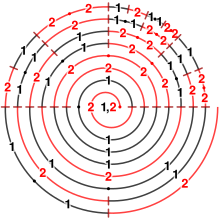
In mathematics, the Kolakoski sequence, sometimes also known as the Oldenburger-Kolakoski sequence, is an infinite sequence of symbols {1,2} that is its own run-length encoding and the prototype for an infinite family of related sequences. It was initially named after the recreational mathematician William Kolakoski (1944–97), who discussed it in 1965, but subsequent research has revealed that it first appeared in a paper by Rufus Oldenburger in 1939.
== Definition of the classic Kolakoski sequence ==
The initial terms of the Kolakoski sequence are:
1,2,2,1,1,2,1,2,2,1,2,2,1,1,2,1,1,2,2,1,2,1,1...